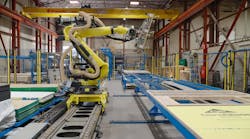At the Textile Museum of Canada (TMC) in downtown Toronto, home to an extensive collection of fabrics, garments, carpets, beadwork, and more, the aging mechanical equipment barely was keeping pace with basic environmental, safety, and security needs. An immediate systemwide overhaul was needed to keep the museum operating as needed.
The TMC looked to Honeywell for help in conducting a thorough evaluation of its building equipment and infrastructure. The analysis found opportunities to improve mechanical-system efficiency and bolster security measures.
Comfort and Control on Display
Honeywell and the TMC embarked on an energy retrofit project involving all of the facility’s major building systems. The first of the project’s three phases was focused on the HVAC systems.
Honeywell redesigned the TMC’s air-distribution system and replaced all major pieces of equipment with new high-efficiency options.
The TMC’s new Honeywell Enterprise Buildings Integrator (EBI) R410 building-automation system integrates and automates core building functions, such as HVAC operations, and provides real-time centralized monitoring and control.
The system features alarm and trending capabilities that allow operators to set limits, such as temperature and humidity parameters, for specific areas in the TMC with sensors and receive notice via alarms if levels exceed those limits. These alarms notify personnel on designated workstations, providing a way to both learn of and change setpoints remotely, a particularly useful feature for after-hours events at the TMC.
EBI also helps to deepen the TMC’s energy savings through easy equipment scheduling and allows personnel to view equipment performance in one detailed graphical representation. The TMC can monitor levels and generate trending information, which it documents and shares with auditors. Any outliers receive a date and time stamp and immediate attention, so the TMC can address issues before they become problems.
Integrated Security Inroads
The second phase of the project included a security overhaul. Honeywell integrated a new security system, extending EBI’s monitoring and control capabilities to include security and provide notification alarms when breaches occur.
The security system features closed-circuit television and more than 20 Honeywell dome cameras throughout the TMC. In addition to providing surveillance footage, the cameras contribute to the facility’s energy-conservation efforts by recording only when they sense movement. The system includes Honeywell Digital Video Manager (DVM), a scalable, Internet Protocol-based digital video system that captures and stores video from the facility’s video cameras for easy retrieval and access.
The TMC’s security system includes a card access system and an asset-locator system, which enables the TMC to equip artifacts with security tags that trigger an alarm if moved beyond a set location. As with the video surveillance system, the asset-locator system ties into the EBI platform.
For the TMC’s card access system, Honeywell installed its Temaline system with standard HID card readers, which enable the TMC to limit access to specific areas. The system includes card readers throughout the facility to help control access without compromising the rest of the facility’s security. The TMC can schedule when doors lock and unlock. Those with cards and access-control rights can simply swipe their card to gain access.
Lighting the Way to Improvements
The third phase of the retrofit project involved the upgrade of the TMC’s lighting, including its 20-year-old light fixtures, tracks, and dimmer switches, which unevenly illuminated exhibits, consuming excessive amounts of electricity in the process. The TMC needed to comply with lighting requirements set forth by the Canadian Conservation Institute (CCI), an organization that supports Canada’s heritage community in preserving collections.
The lighting transformation entailed moving from traditional incandescent lighting to a mix of standard lighting and track lighting, including energy-efficient LED bulbs, wall-washer and flood-fixture lighting, and T8 fluorescent tubes. The upgrades also included a new dimming system integrated with special lighting-control software.
By going this energy-efficient-lighting route, the TMC qualified for energy incentives through the Ontario Power Authority’s Save on Energy program. These upgrades helped the TMC meet CCI requirements related to lighting color, brightness, and temperature.
Bridging Benefits for Future Success
With one eye toward the past as it presents historic textiles from around the world, the TMC now has its other eye on the present and future as it realizes the long-term benefits of the facility retrofit project. Initial benefits included the expected time and efficiency savings brought on by enhanced control and system integration. Because of the system’s integration capabilities, the TMC will be able to expand the building-automation system to include other systems and capabilities it chooses to bring online in the future, further driving savings and benefits.
For Design Solutions author guidelines, call Scott Arnold, executive editor, at 216-931-9980, or write to him at [email protected].










